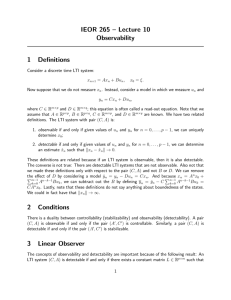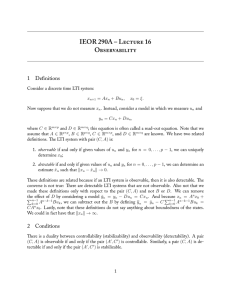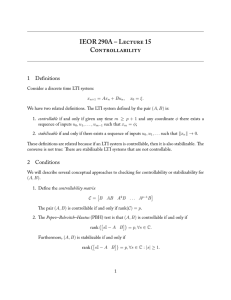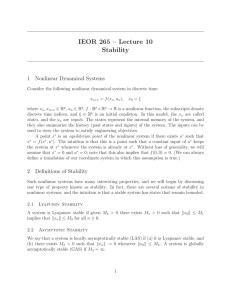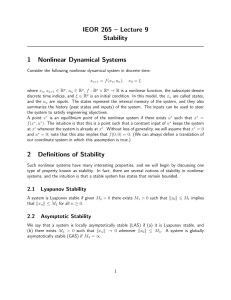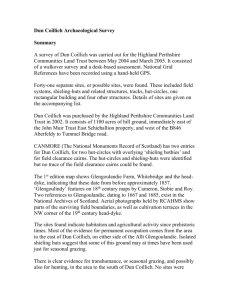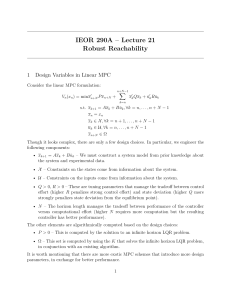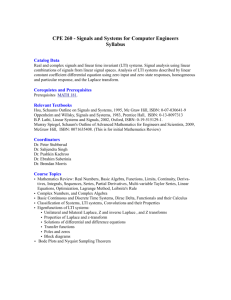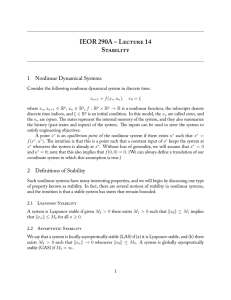IEOR 265 – Lecture 11 Observability 1 Definitions
advertisement
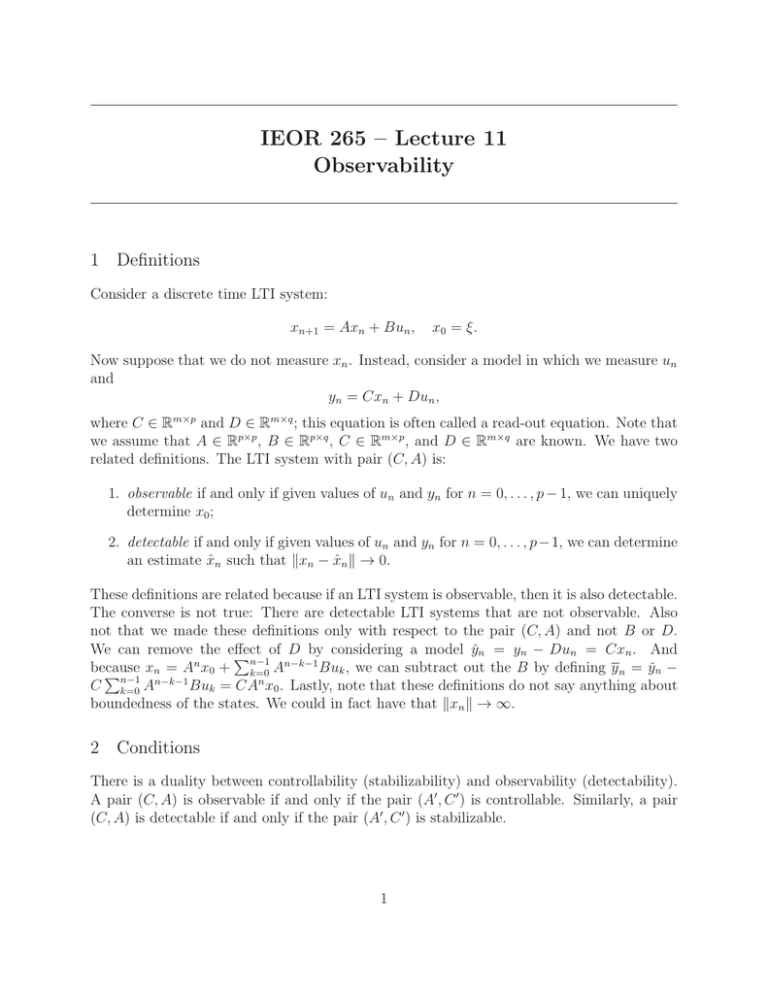
IEOR 265 – Lecture 11 Observability 1 Definitions Consider a discrete time LTI system: xn+1 = Axn + Bun , x0 = ξ. Now suppose that we do not measure xn . Instead, consider a model in which we measure un and yn = Cxn + Dun , where C ∈ Rm×p and D ∈ Rm×q ; this equation is often called a read-out equation. Note that we assume that A ∈ Rp×p , B ∈ Rp×q , C ∈ Rm×p , and D ∈ Rm×q are known. We have two related definitions. The LTI system with pair (C, A) is: 1. observable if and only if given values of un and yn for n = 0, . . . , p − 1, we can uniquely determine x0 ; 2. detectable if and only if given values of un and yn for n = 0, . . . , p− 1, we can determine an estimate x̂n such that kxn − x̂n k → 0. These definitions are related because if an LTI system is observable, then it is also detectable. The converse is not true: There are detectable LTI systems that are not observable. Also not that we made these definitions only with respect to the pair (C, A) and not B or D. We can remove the effect D by considering a model y̌n = yn − Dun = Cxn . And Pn−1of n−k−1 n A Buk , we can subtract out the B by defining y n = y̌n − because x = A x + k=0 Pn−1 nn−k−1 0 n C k=0 A Buk = CA x0 . Lastly, note that these definitions do not say anything about boundedness of the states. We could in fact have that kxn k → ∞. 2 Conditions There is a duality between controllability (stabilizability) and observability (detectability). A pair (C, A) is observable if and only if the pair (A′ , C ′ ) is controllable. Similarly, a pair (C, A) is detectable if and only if the pair (A′ , C ′ ) is stabilizable. 1 3 Linear Observer The concepts of observability and detectability are important because of the following result: An LTI system (C, A) is detectable if and only if there exists a constant matrix L ∈ Rp×m such that A + LC is stable. To understand why this is relevant, suppose that we choose the following estimate x̂n+1 = Ax̂n + Bun + L(ŷn − y), ŷn = C xˆn + Dun . x̂0 = φ Now if we define the estimation error as en = x̂n − xn , then we have en+1 = x̂n+1 − xn+1 = Ax̂n + Bun + L(C xˆn + Dun − Cxn − Dun ) − Axn − Bun = (A + LC)(x̂n − xn ) = (A + LC)en , meaning that ken k = kx̂n − xn k → 0 because A + LC is stable. The condition of observability is even more powerful. Let λ1 , λ2 , . . . , λp ∈ C be fixed complex numbers. If (C, A) is observable, then there exists an L such that the eigenvalues of A + LC are precisely the λ1 , λ2 , . . . , λp that were chosen. 4 Steady State Kalman Filter Consider the following LTI system with noise: xn+1 = Axn + vn yn = Cxn + wn where vn ∼ N (0, Q) is process noise (or state noise) and wn ∼ N (0, R) is measurement noise. The initial condition to this system is x0 ∼ N (µ, Σ0 ). For simplicity, we will assume that Q > 0 and R > 0. Based on this system, consider the following optimization problem h i lim min E (x̂n+1 − xn+1 )′ (x̂n+1 − xn+1 ) n→∞ s.t. xk+1 = Axk + vk yk = Cxk + wk vk ∼ N (0, Q) wk ∼ N (0, R) Note that this minimum may not be finite unless we impose additional restrictions. In particular, suppose that (C, A) is detectible. Then the minimizer is given by x̂n+1 = Ax̂n + L(ŷn − y) (i.e., linear observer with constant gain), where L = −AP C ′ (R + CP C ′ )−1 2 and P > 0 is the unique solution to the discrete time algebraic Riaccati equation (DARE) P = Q + A(P − P C ′ (R + CP C ′ )−1 CP )A′ . If K is the feedback gain for the infinite horizon LQR problem with pair (A′ , C ′ ), then we actually have that K = L′ ; in other words, there is a duality between the infinite horizon LQR problem and the steady-state Kalman filter gain. 5 Separation Principle Suppose we have an LTI system in which (A, B) is stabilizable and (C, A) is detectable. And imagine that we do not have access to measurements of xn , rather we only measure un and yn . An interesting question to what happens if we use an observer to produce estimates x̂n , and then uses these estimates with a linear feedback to control the system? Is the resulting closed-loop system stable? It turns out that the answer is yes, and the answer lets us separate the observer design from the controller design. In particular, consider an output-feedback controller x̂n+1 = Ax̂n + Bun + L(C x̂n + Dun − yn ) un = K x̂n , where K, L are any matrices such that (A + BK) and (A + LC) are stable. Note that the closed-loop system is given by xn A BK xn+1 . = −LC A + BK + LC x̂n x̂n+1 Next consider a change of variables xn I 0 xn . = −I I x̂n en Then the dynamics in this new coordinate system are given by −1 xn I 0 A BK xn+1 I 0 = en −I I −I I −LC A + BK + LC en+1 I 0 xn A BK = −LC − A A + LC I I en xn A + BK BK = 0 A + LC en The eigenvalues of this block matrix are precisely the eigenvalues of A + BK and A + LC, and so the closed-loop system as long as A + BK and A + LC are both individually stable. 3
